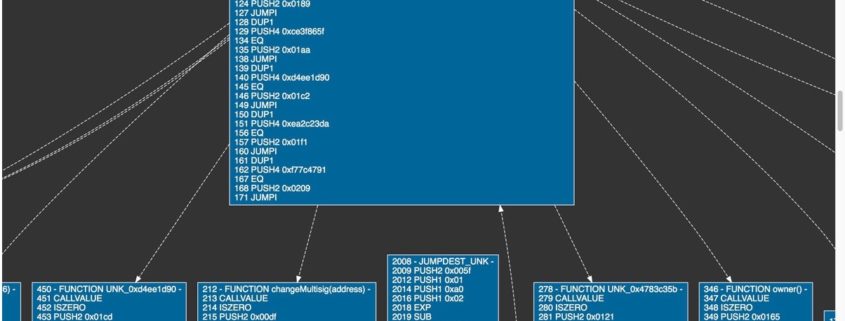Introducing Mythril: A framework for bug hunting on the Ethereum blockchain
Unless you’ve been living under a rock for the past three years, you have surely taken notice of an industry buzzword that has been giving “machine learning” a run for its money: Blockchain.
Ethereum is one of the most successful implementations of the distributed blockchain concept. In contrast to Bitcoin, which offers limited scripting capabilities, Ethereum provides a Turing-complete virtual machine. State transitions in the network (such as a changes in account balance of a particular token) are regulated by code running in the virtual machine, a.k.a. “smart contracts”.
An ancient security saying goes: “With great flexibility comes great potential for vulnerabilities”. It doesn’t help that the semantics of Ethereum’s most popular high-level programming language Solidity are often counter-intuitive, creating many possibilities for developers to mess up. A great example for this is the Parity multisig wallet bug, which allowed an unknown attacker to withdraw 153,037 Ether (worth more that USD 30 million) after their tinder date turned out to be a real creep.
The Parity debacle shows that implementation errors can remain undetected for months, even when the contract is deployed on the mainnet and its source code is openly available. One can only speculate what kind of vulnerabilities might be hidden in the thousands contracts deployed on the chain, many of which are black-boxes (in the sense that the source code isn’t published on Etherscan).
Not surprisingly, such a rich source of potential vulnerabilities with a monetary payout doesn’t escape the attention of security folks of the “white-hat” and “black-hat” varieties. It’s smashing the stack* for fun and profit all over again — only this time there is real profit (*note that not only does the EVM have a stack, it also doesn’t have registers, so almost every instruction uses the stack).
When I started looking into Ethereum a few weeks ago, I found quite a few useful tools for analyzing contracts on the mainnet. Etherscan and remix allow researchers to conveniently browse, disassemble and debug contracts in the web browser. The Porosity decompiler can (to a certain extent) restore source code from a given bytecode. Truffle and testrpc make it easy to compile and debug Solidity code.
However, I also found that there were many things I couldn’t do efficiently: Most notably, searching the blockchain for interesting contracts and scripting static/dynamic analysis in Python (I haven’t quite jumped on the doing-everything-in-JavaScript train yet). Therefore, I started writing up a collection of Python modules and a command line tool. And crucially, I polished the thing to a point where others might be able to use it. The outcome is Mythril, an Ethereum disassembler / blockchain exploration & analysis tool. A brief tutorial follows.
Setup
Originally, I was hoping to run PyEthApp and directly access the state in its LevelDB. Unfortunately, PyEthApp seems to have suffered a lack of maintenance and development for quite some time and doesn’t sync with the Ethereum mainnet. Mythril therefore needs RPC access to a fully connected go-ethereum node. Install go-ethereum and start your node as follows:
$ geth --rpc --rpcapi eth,debug --syncmode fast console 2>/dev/null
Note that Mythril uses non-standard go-ethereum debug APIs, so some while it should work with other Ethereum clients, some functions won’t be available.
Continue reading/ Source: https://hackernoon.com





Hinterlasse einen Kommentar
An der Diskussion beteiligen?Hinterlasse uns deinen Kommentar!